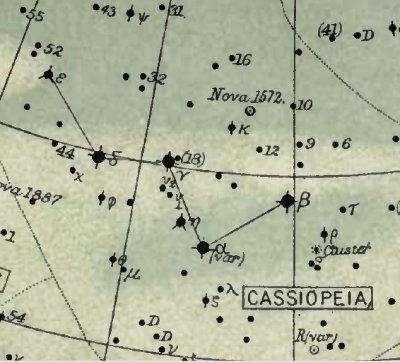Ball's Popular Guide to the Heavens
 Sun 2007-06-17
Sun 2007-06-17 
I date my interest in variable stars back to May 1971. I was 12 years old, at a bit of a loose end, and on the lookout for something to interest me. One week my younger brother Gavin was doing a school project on the planets and borrowed two books from the town library to help him. One of these books was "A Popular Guide to the Heavens" by Robert Stawell Ball, the other was "Naked Eye Astronomy" by Patrick Moore (which I might get round to talking about some other time). I don't know how much use they were to Gavin, probably not very much, but I picked them up, glanced through them and became hooked.
Ball's Popular Guide was an old, almost Victorian book first published in 1905 but the edition we had was from 1920. It's subtitle "A Series of Eighty-Three Plates with Explanatory Text & Index" actually sums it up quite well. It is basically just a set of astronomical diagrams, photographs, tables, and charts with explanatory text and tables.
What fascinated me most were the star charts which showed stars down to the 6th magnitude. I had tried to find my way round the sky when I was younger but the books I had then (such as The Ladybird Book of Astronomy) had only fragmentary star charts which showed only some of the brighter stars. Now I had a complete map and could find my way around! I taught myself the constellations, mainly by copying them out with pencil and paper. I would carefully draw the stars as dots of the correct size for their brightness, and then join them up by lines to form the constellation shapes. I started drawing charts for variable stars, such as Beta Persei, Gamma Cassiopeiae and Beta Pegasi, showing how to find the star and which stars to compare its brightness against.
And I started to feel that deep longing for clear dark skies that afflicts astronomers. During late May, June and July, it doesn't get dark until around 11pm from the north of England. In the evenings I would sit reading a book at the living room table, from which I could see out into the back garden. When I judged it dark enough, I would close the living room curtains leaving just a thin gap for light to leak through into the back garden so I would be able to read my charts when outside. This gap would also allow me to look in to see the time on the living room clock. I would then go out, sit on the wooden garden seat (long since replaced), and try pick out the stars on the charts I had drawn. Initially I was not as systematic and efficient as I became in later years. For the first few months I didn't even record my results in a notebook.
I also remember the thrill of first night I stayed out in the garden till after my parents had gone to bed. I crept back indoors, remembering to lock the door behind me, and turned off the lights before going upstairs to bed. Later I would take my shoes off before going upstairs, so as to make as little noise as possible.
Within a couple of years I had outgrown Ball's Popular Guide; I had moved on to bigger and better star maps reaching down to the 8th magnitude. I stopped borrowing it from the library, and slowly it slipped from my consciousness. A few years later the library withdrew it from their shelves and I never saw that copy again.
In 1972 I joined the British Astronomical Association and started corresponding with other variable star observers. The mathematical demands of this interest had the side-effect that I moved from being in the bottom third of the maths class at school to the top third. Over the following 21 years I made many thousands of variable star observations and the need to be able to process this mass of data lead me to an interest in computers which lead, via a degree course in Computing Science, to my current job of software engineer. I actually see my current job as a direct consequence of that interest that was sparked, in part, by Ball's Popular Guide back in May 1971.
A couple of months ago I came across an online copy of Ball's Popular Guide at the Internet Archive. Scrolling through pages that I had not seen for over 30 years brought back many happy memories from that time. (I should warn you that the scanned-in PDF file is rather large and hence slow to download and to scroll through. It should really have been edited down to remove the blank pages). The above map of Cassiopeia gives a flavor of what its star maps are like. Notice the curved lines used to delineate the boundaries between constellations. The modern straight-line constellation boundaries were not introduced until 1930. Also, below is Edward Emerson Barnard's explanation of why Jupiter's moon Io sometimes appears double and sometimes appears elongated when crossing the face of the planet.


Reader Comments (1)
Ball's book may also be available at Google Books.